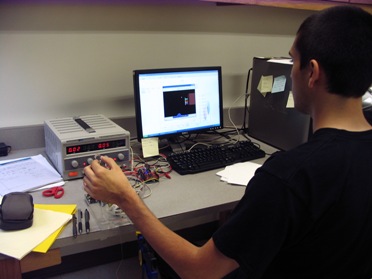
Haptics in Education: Haptic Paddle
At California State University, Long Beach (CSULB), the MATLAB/Simulink Haptic Paddle system is used in two Mechanical Engineering courses, a freshman-level Introduction to Mechanical Engineering course (MAE 101B) and a graduate-level course in Haptic Systems (MAE 578). In MAE 101B, the Haptic Paddle helps students learn basic physics and mechanical engineering principles through visualization and force feedback simulation. At the graduate-level, the system will be used to teach analysis and design of haptic interfaces and force-feedback simulations.
MAE 101B: Introduction to Mechanical Engineering
(Course offered every Spring semester)

MAE 101B is a 1-unit course that introduces first-year mechanical engineering students to the profession and topics including basic mathematical and engineering fundamentals, engineering design, and creative thinking and problem solving skills. In the Spring 2011 semester, a learning module on Hooke's law and equivalent spring stiffness was created on MATLAB/Simulink Haptic Paddle. The simulation allows the user to adjust the spring stiffness coefficients and the types of connection (serial/parallel). Using the simulation, students can explore the spring equations, validate their results, and feel the spring force through the Haptic Paddle. At this first implementation, the students used the learning module on a voluntary basis.
Lab Materials: Linear springs handout
MATLAB Codes: Linear springs simulation
MAE 578: Haptic Systems for Virtual Reality and Teleoperation
(Course offered every even Spring semester)
At the graduate-level, students in MAE 578 will be introduced to the design of haptic interfaces, haptic rendering and modeling of virtual environments, and their applications. The haptic paddle will be integrated as part of the final course project. Students will assemble the paddle and create a virtual lesson related to an undergraduate-level math and/or mechanical engineering topic of their choice. Examples of a virtual lesson include mass-spring system (related to dynamics), stress and strain (related to mechanics of materials), and basic mechanical components such as springs and gears (related to machine components and design). The project provides the graduate students with hands-on experience with a haptic interface, device control, and haptic rendering techniques using MATLAB/Simulink framework. The resulted simulations can also be used to teach undergraduate students.
Lab Material: Coming soon
MATLAB Code: Coming soon
Click here to return to the main project page at Vanderbilt University.